Advanced Accounting: PPE Revaluation's Impact on Financial Statements
VerifiedAdded on 2023/06/11
|5
|1245
|192
Essay
AI Summary
This essay delves into the complexities of Property, Plant, and Equipment (PPE) revaluation within the context of advanced financial accounting. It addresses the motivations behind directors' decisions not to revalue PPE, considering factors such as revaluation costs, potential inconsistencies with historical cost accounting principles, and the impact on financial statement accuracy. The essay further examines the effects of these decisions on a firm's financial statements, particularly concerning the true and fair representation of asset values and the potential for misleading information. Finally, it assesses whether the decision not to revalue adversely affects shareholder wealth, highlighting the importance of reflecting current market values in asset valuations and the implications for shareholder equity. The analysis draws upon accounting standards and relevant literature to provide a comprehensive understanding of PPE revaluation and its implications for financial reporting and stakeholder value. Desklib offers a wealth of similar solved assignments and past papers to aid students in their studies.
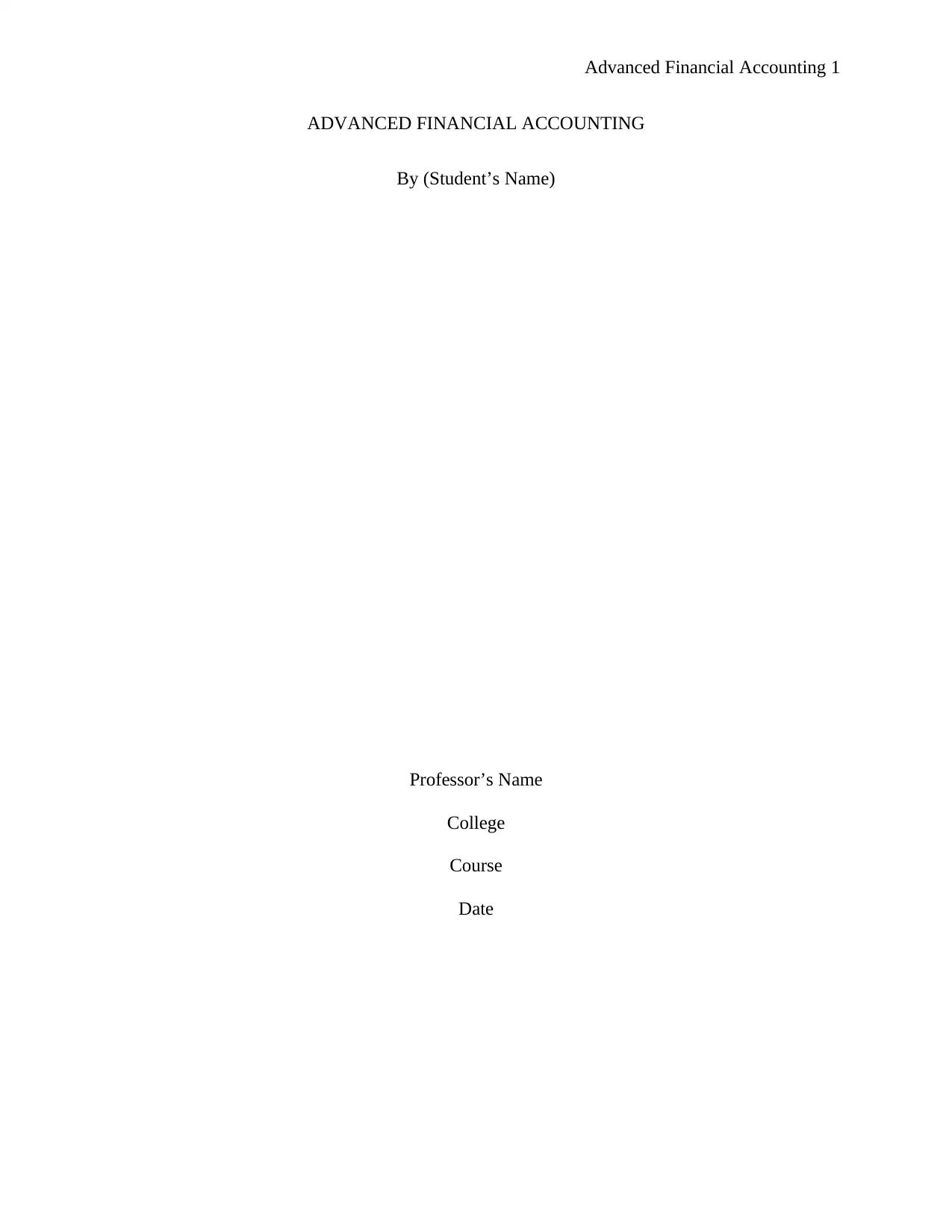
Advanced Financial Accounting 1
ADVANCED FINANCIAL ACCOUNTING
By (Student’s Name)
Professor’s Name
College
Course
Date
ADVANCED FINANCIAL ACCOUNTING
By (Student’s Name)
Professor’s Name
College
Course
Date
Paraphrase This Document
Need a fresh take? Get an instant paraphrase of this document with our AI Paraphraser
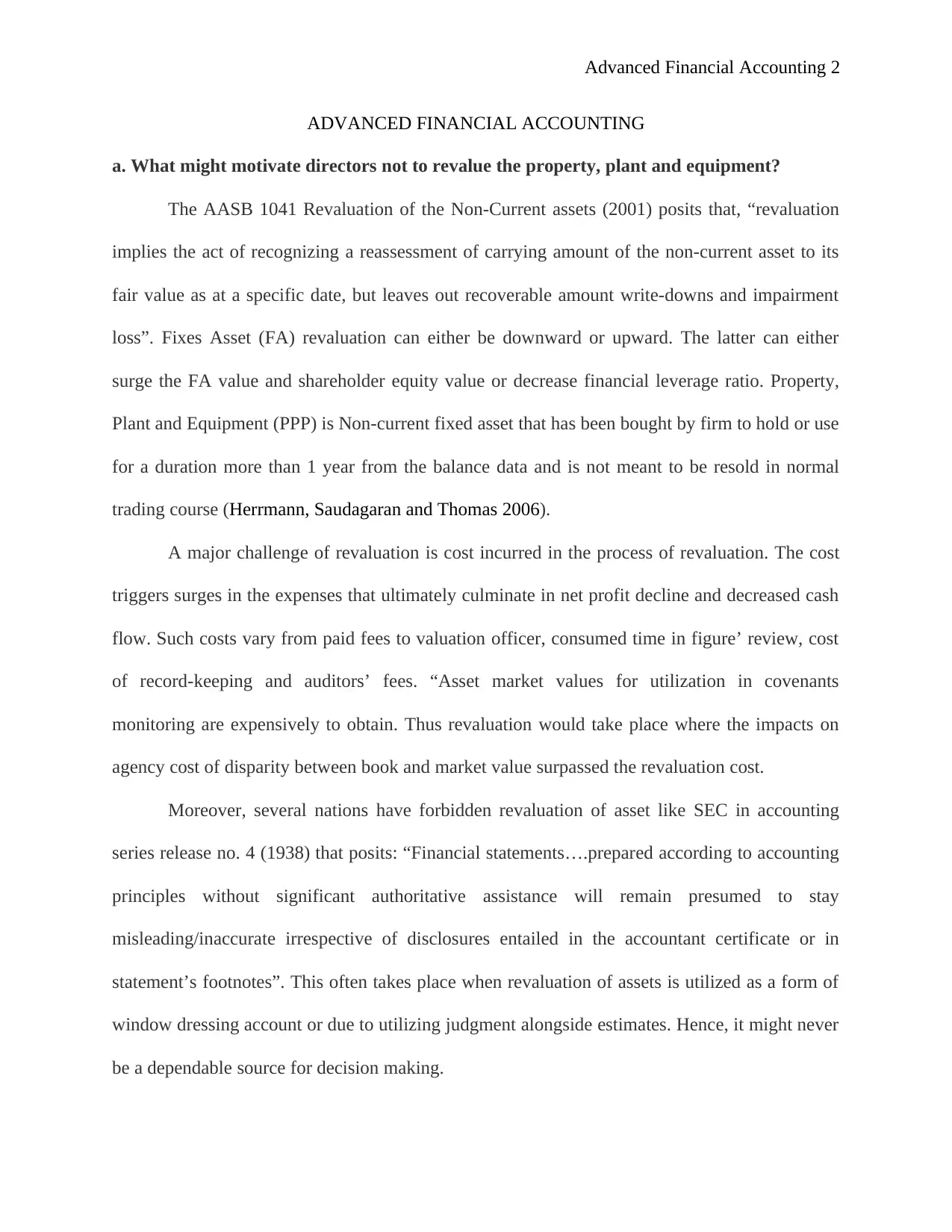
Advanced Financial Accounting 2
ADVANCED FINANCIAL ACCOUNTING
a. What might motivate directors not to revalue the property, plant and equipment?
The AASB 1041 Revaluation of the Non-Current assets (2001) posits that, “revaluation
implies the act of recognizing a reassessment of carrying amount of the non-current asset to its
fair value as at a specific date, but leaves out recoverable amount write-downs and impairment
loss”. Fixes Asset (FA) revaluation can either be downward or upward. The latter can either
surge the FA value and shareholder equity value or decrease financial leverage ratio. Property,
Plant and Equipment (PPP) is Non-current fixed asset that has been bought by firm to hold or use
for a duration more than 1 year from the balance data and is not meant to be resold in normal
trading course (Herrmann, Saudagaran and Thomas 2006).
A major challenge of revaluation is cost incurred in the process of revaluation. The cost
triggers surges in the expenses that ultimately culminate in net profit decline and decreased cash
flow. Such costs vary from paid fees to valuation officer, consumed time in figure’ review, cost
of record-keeping and auditors’ fees. “Asset market values for utilization in covenants
monitoring are expensively to obtain. Thus revaluation would take place where the impacts on
agency cost of disparity between book and market value surpassed the revaluation cost.
Moreover, several nations have forbidden revaluation of asset like SEC in accounting
series release no. 4 (1938) that posits: “Financial statements….prepared according to accounting
principles without significant authoritative assistance will remain presumed to stay
misleading/inaccurate irrespective of disclosures entailed in the accountant certificate or in
statement’s footnotes”. This often takes place when revaluation of assets is utilized as a form of
window dressing account or due to utilizing judgment alongside estimates. Hence, it might never
be a dependable source for decision making.
ADVANCED FINANCIAL ACCOUNTING
a. What might motivate directors not to revalue the property, plant and equipment?
The AASB 1041 Revaluation of the Non-Current assets (2001) posits that, “revaluation
implies the act of recognizing a reassessment of carrying amount of the non-current asset to its
fair value as at a specific date, but leaves out recoverable amount write-downs and impairment
loss”. Fixes Asset (FA) revaluation can either be downward or upward. The latter can either
surge the FA value and shareholder equity value or decrease financial leverage ratio. Property,
Plant and Equipment (PPP) is Non-current fixed asset that has been bought by firm to hold or use
for a duration more than 1 year from the balance data and is not meant to be resold in normal
trading course (Herrmann, Saudagaran and Thomas 2006).
A major challenge of revaluation is cost incurred in the process of revaluation. The cost
triggers surges in the expenses that ultimately culminate in net profit decline and decreased cash
flow. Such costs vary from paid fees to valuation officer, consumed time in figure’ review, cost
of record-keeping and auditors’ fees. “Asset market values for utilization in covenants
monitoring are expensively to obtain. Thus revaluation would take place where the impacts on
agency cost of disparity between book and market value surpassed the revaluation cost.
Moreover, several nations have forbidden revaluation of asset like SEC in accounting
series release no. 4 (1938) that posits: “Financial statements….prepared according to accounting
principles without significant authoritative assistance will remain presumed to stay
misleading/inaccurate irrespective of disclosures entailed in the accountant certificate or in
statement’s footnotes”. This often takes place when revaluation of assets is utilized as a form of
window dressing account or due to utilizing judgment alongside estimates. Hence, it might never
be a dependable source for decision making.
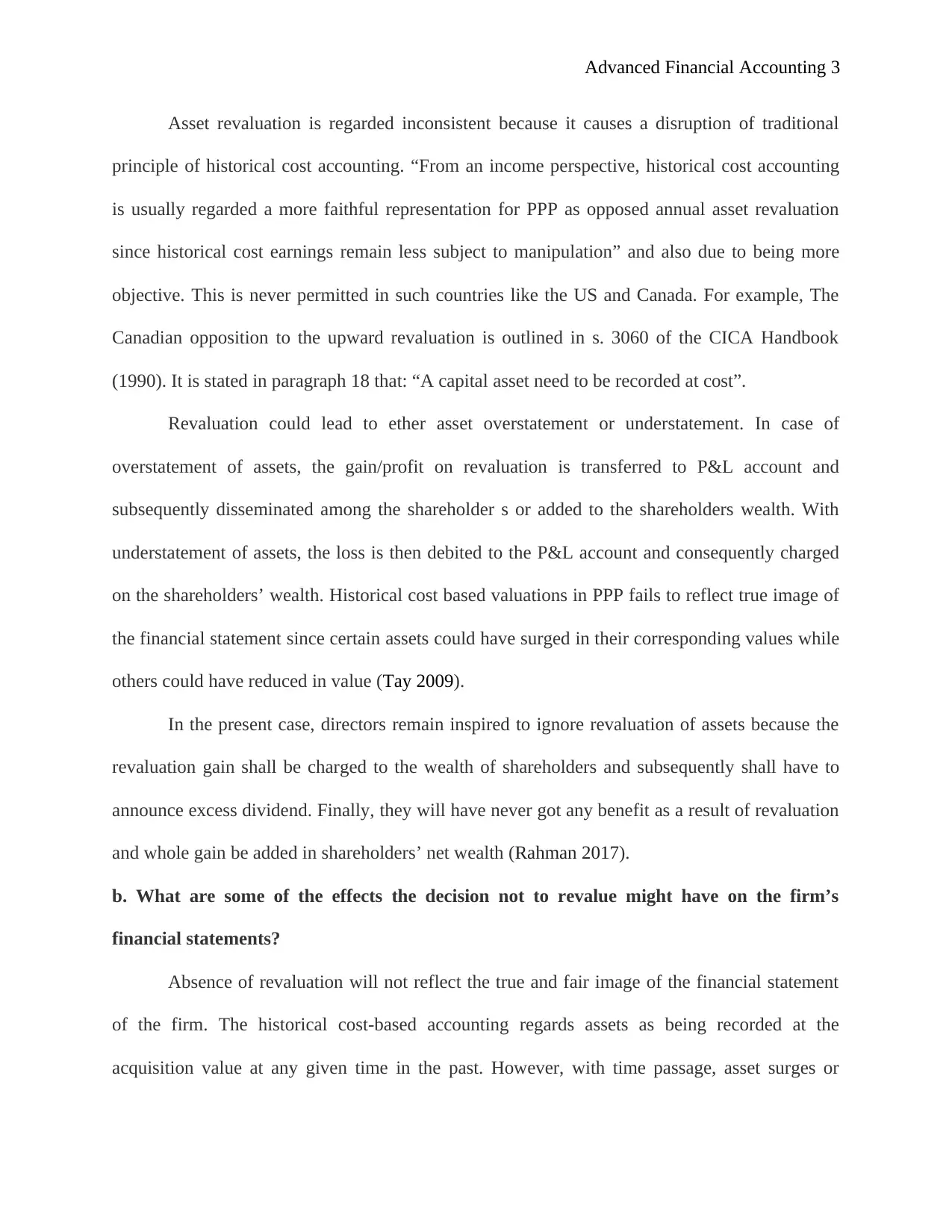
Advanced Financial Accounting 3
Asset revaluation is regarded inconsistent because it causes a disruption of traditional
principle of historical cost accounting. “From an income perspective, historical cost accounting
is usually regarded a more faithful representation for PPP as opposed annual asset revaluation
since historical cost earnings remain less subject to manipulation” and also due to being more
objective. This is never permitted in such countries like the US and Canada. For example, The
Canadian opposition to the upward revaluation is outlined in s. 3060 of the CICA Handbook
(1990). It is stated in paragraph 18 that: “A capital asset need to be recorded at cost”.
Revaluation could lead to ether asset overstatement or understatement. In case of
overstatement of assets, the gain/profit on revaluation is transferred to P&L account and
subsequently disseminated among the shareholder s or added to the shareholders wealth. With
understatement of assets, the loss is then debited to the P&L account and consequently charged
on the shareholders’ wealth. Historical cost based valuations in PPP fails to reflect true image of
the financial statement since certain assets could have surged in their corresponding values while
others could have reduced in value (Tay 2009).
In the present case, directors remain inspired to ignore revaluation of assets because the
revaluation gain shall be charged to the wealth of shareholders and subsequently shall have to
announce excess dividend. Finally, they will have never got any benefit as a result of revaluation
and whole gain be added in shareholders’ net wealth (Rahman 2017).
b. What are some of the effects the decision not to revalue might have on the firm’s
financial statements?
Absence of revaluation will not reflect the true and fair image of the financial statement
of the firm. The historical cost-based accounting regards assets as being recorded at the
acquisition value at any given time in the past. However, with time passage, asset surges or
Asset revaluation is regarded inconsistent because it causes a disruption of traditional
principle of historical cost accounting. “From an income perspective, historical cost accounting
is usually regarded a more faithful representation for PPP as opposed annual asset revaluation
since historical cost earnings remain less subject to manipulation” and also due to being more
objective. This is never permitted in such countries like the US and Canada. For example, The
Canadian opposition to the upward revaluation is outlined in s. 3060 of the CICA Handbook
(1990). It is stated in paragraph 18 that: “A capital asset need to be recorded at cost”.
Revaluation could lead to ether asset overstatement or understatement. In case of
overstatement of assets, the gain/profit on revaluation is transferred to P&L account and
subsequently disseminated among the shareholder s or added to the shareholders wealth. With
understatement of assets, the loss is then debited to the P&L account and consequently charged
on the shareholders’ wealth. Historical cost based valuations in PPP fails to reflect true image of
the financial statement since certain assets could have surged in their corresponding values while
others could have reduced in value (Tay 2009).
In the present case, directors remain inspired to ignore revaluation of assets because the
revaluation gain shall be charged to the wealth of shareholders and subsequently shall have to
announce excess dividend. Finally, they will have never got any benefit as a result of revaluation
and whole gain be added in shareholders’ net wealth (Rahman 2017).
b. What are some of the effects the decision not to revalue might have on the firm’s
financial statements?
Absence of revaluation will not reflect the true and fair image of the financial statement
of the firm. The historical cost-based accounting regards assets as being recorded at the
acquisition value at any given time in the past. However, with time passage, asset surges or
⊘ This is a preview!⊘
Do you want full access?
Subscribe today to unlock all pages.

Trusted by 1+ million students worldwide
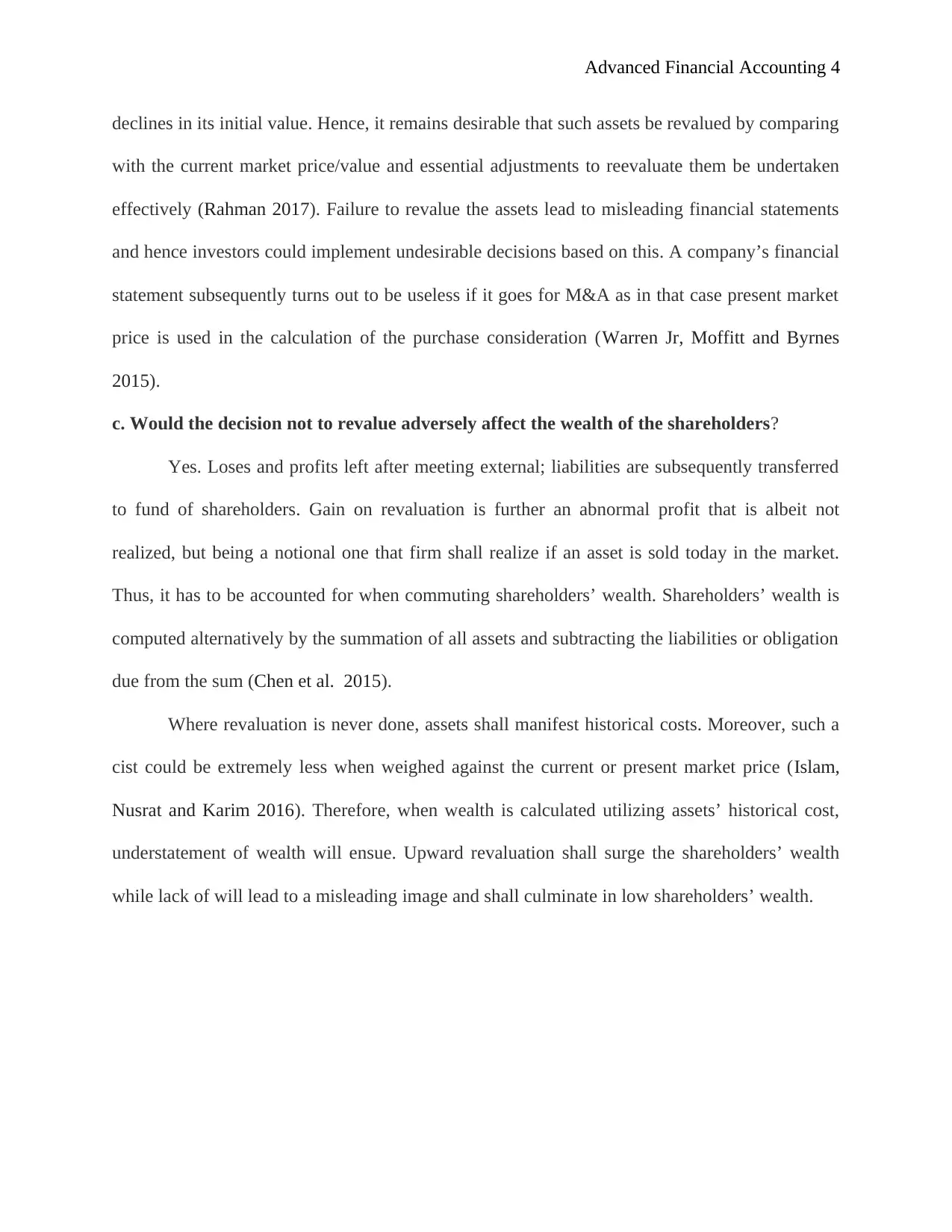
Advanced Financial Accounting 4
declines in its initial value. Hence, it remains desirable that such assets be revalued by comparing
with the current market price/value and essential adjustments to reevaluate them be undertaken
effectively (Rahman 2017). Failure to revalue the assets lead to misleading financial statements
and hence investors could implement undesirable decisions based on this. A company’s financial
statement subsequently turns out to be useless if it goes for M&A as in that case present market
price is used in the calculation of the purchase consideration (Warren Jr, Moffitt and Byrnes
2015).
c. Would the decision not to revalue adversely affect the wealth of the shareholders?
Yes. Loses and profits left after meeting external; liabilities are subsequently transferred
to fund of shareholders. Gain on revaluation is further an abnormal profit that is albeit not
realized, but being a notional one that firm shall realize if an asset is sold today in the market.
Thus, it has to be accounted for when commuting shareholders’ wealth. Shareholders’ wealth is
computed alternatively by the summation of all assets and subtracting the liabilities or obligation
due from the sum (Chen et al. 2015).
Where revaluation is never done, assets shall manifest historical costs. Moreover, such a
cist could be extremely less when weighed against the current or present market price (Islam,
Nusrat and Karim 2016). Therefore, when wealth is calculated utilizing assets’ historical cost,
understatement of wealth will ensue. Upward revaluation shall surge the shareholders’ wealth
while lack of will lead to a misleading image and shall culminate in low shareholders’ wealth.
declines in its initial value. Hence, it remains desirable that such assets be revalued by comparing
with the current market price/value and essential adjustments to reevaluate them be undertaken
effectively (Rahman 2017). Failure to revalue the assets lead to misleading financial statements
and hence investors could implement undesirable decisions based on this. A company’s financial
statement subsequently turns out to be useless if it goes for M&A as in that case present market
price is used in the calculation of the purchase consideration (Warren Jr, Moffitt and Byrnes
2015).
c. Would the decision not to revalue adversely affect the wealth of the shareholders?
Yes. Loses and profits left after meeting external; liabilities are subsequently transferred
to fund of shareholders. Gain on revaluation is further an abnormal profit that is albeit not
realized, but being a notional one that firm shall realize if an asset is sold today in the market.
Thus, it has to be accounted for when commuting shareholders’ wealth. Shareholders’ wealth is
computed alternatively by the summation of all assets and subtracting the liabilities or obligation
due from the sum (Chen et al. 2015).
Where revaluation is never done, assets shall manifest historical costs. Moreover, such a
cist could be extremely less when weighed against the current or present market price (Islam,
Nusrat and Karim 2016). Therefore, when wealth is calculated utilizing assets’ historical cost,
understatement of wealth will ensue. Upward revaluation shall surge the shareholders’ wealth
while lack of will lead to a misleading image and shall culminate in low shareholders’ wealth.
Paraphrase This Document
Need a fresh take? Get an instant paraphrase of this document with our AI Paraphraser
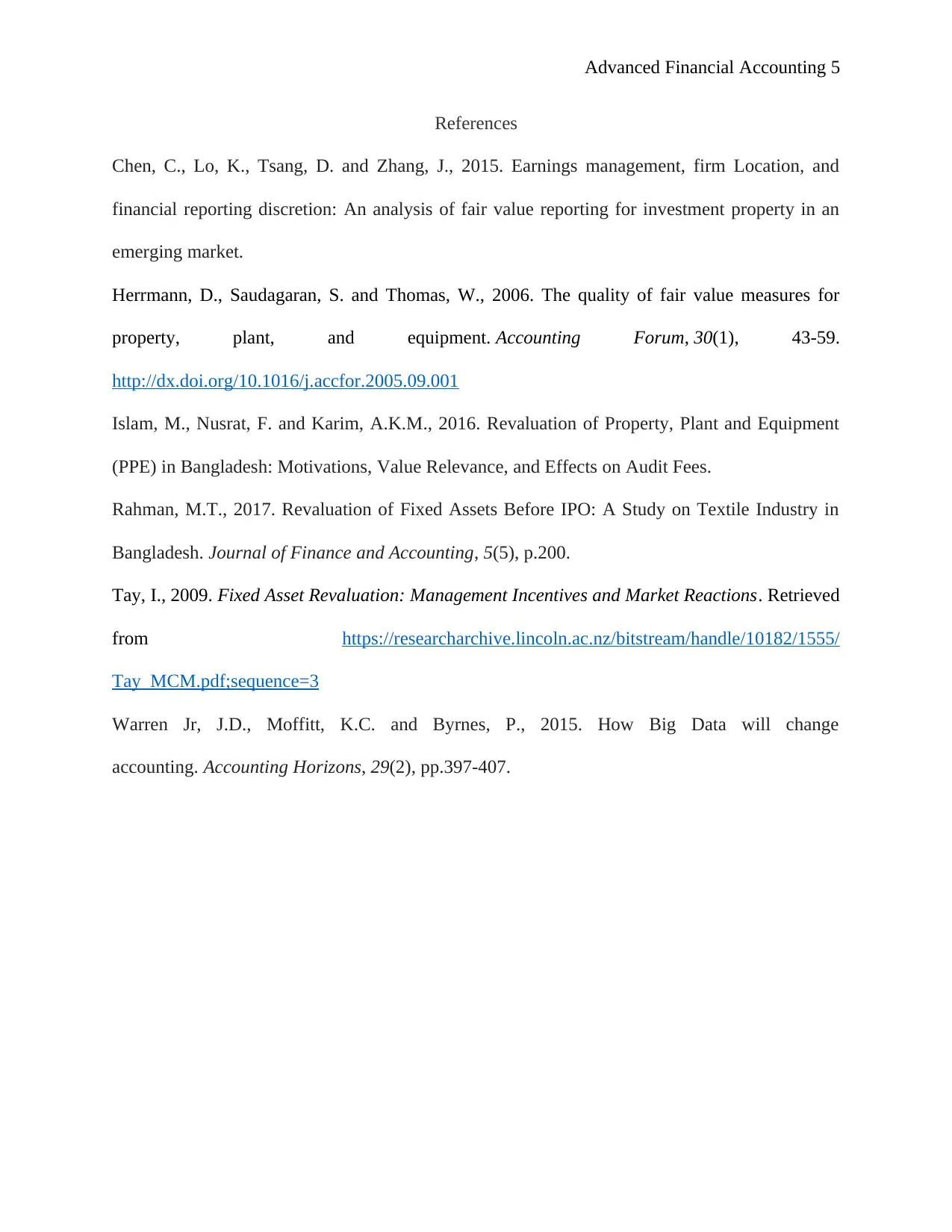
Advanced Financial Accounting 5
References
Chen, C., Lo, K., Tsang, D. and Zhang, J., 2015. Earnings management, firm Location, and
financial reporting discretion: An analysis of fair value reporting for investment property in an
emerging market.
Herrmann, D., Saudagaran, S. and Thomas, W., 2006. The quality of fair value measures for
property, plant, and equipment. Accounting Forum, 30(1), 43-59.
http://dx.doi.org/10.1016/j.accfor.2005.09.001
Islam, M., Nusrat, F. and Karim, A.K.M., 2016. Revaluation of Property, Plant and Equipment
(PPE) in Bangladesh: Motivations, Value Relevance, and Effects on Audit Fees.
Rahman, M.T., 2017. Revaluation of Fixed Assets Before IPO: A Study on Textile Industry in
Bangladesh. Journal of Finance and Accounting, 5(5), p.200.
Tay, I., 2009. Fixed Asset Revaluation: Management Incentives and Market Reactions. Retrieved
from https://researcharchive.lincoln.ac.nz/bitstream/handle/10182/1555/
Tay_MCM.pdf;sequence=3
Warren Jr, J.D., Moffitt, K.C. and Byrnes, P., 2015. How Big Data will change
accounting. Accounting Horizons, 29(2), pp.397-407.
References
Chen, C., Lo, K., Tsang, D. and Zhang, J., 2015. Earnings management, firm Location, and
financial reporting discretion: An analysis of fair value reporting for investment property in an
emerging market.
Herrmann, D., Saudagaran, S. and Thomas, W., 2006. The quality of fair value measures for
property, plant, and equipment. Accounting Forum, 30(1), 43-59.
http://dx.doi.org/10.1016/j.accfor.2005.09.001
Islam, M., Nusrat, F. and Karim, A.K.M., 2016. Revaluation of Property, Plant and Equipment
(PPE) in Bangladesh: Motivations, Value Relevance, and Effects on Audit Fees.
Rahman, M.T., 2017. Revaluation of Fixed Assets Before IPO: A Study on Textile Industry in
Bangladesh. Journal of Finance and Accounting, 5(5), p.200.
Tay, I., 2009. Fixed Asset Revaluation: Management Incentives and Market Reactions. Retrieved
from https://researcharchive.lincoln.ac.nz/bitstream/handle/10182/1555/
Tay_MCM.pdf;sequence=3
Warren Jr, J.D., Moffitt, K.C. and Byrnes, P., 2015. How Big Data will change
accounting. Accounting Horizons, 29(2), pp.397-407.
1 out of 5
Related Documents
Your All-in-One AI-Powered Toolkit for Academic Success.
+13062052269
info@desklib.com
Available 24*7 on WhatsApp / Email
![[object Object]](/_next/static/media/star-bottom.7253800d.svg)
Unlock your academic potential
Copyright © 2020–2025 A2Z Services. All Rights Reserved. Developed and managed by ZUCOL.





